Critique of Research: Patient Repositioning for Pressure Ulcers
VerifiedAdded on 2023/01/19
|17
|6086
|1
Report
AI Summary
This report presents a comprehensive critique of research concerning pressure ulcers, particularly focusing on the effectiveness of patient repositioning in preventing these conditions. The report begins with a background on pressure ulcers, detailing the associated costs and health risks, followed by a description of the search strategy employed to identify relevant research articles. The critique analyzes the research design, data collection methods (primarily quantitative), sampling techniques, and ethical considerations of a selected article. The aim of the research, the use of the PICO framework, and the application of the CASP tool for evaluation are discussed. The analysis explores the strengths and weaknesses of the chosen research methods, including the use of convenience sampling and the limitations of the study. The report also includes an evaluation of the study's ethical considerations and concludes with a summary of key points and suggestions for further research, emphasizing the importance of effective repositioning practices to reduce the risk of pressure ulcers in bedridden patients. The report provides a detailed evaluation of the chosen article and its relevance to the topic of pressure ulcer prevention.
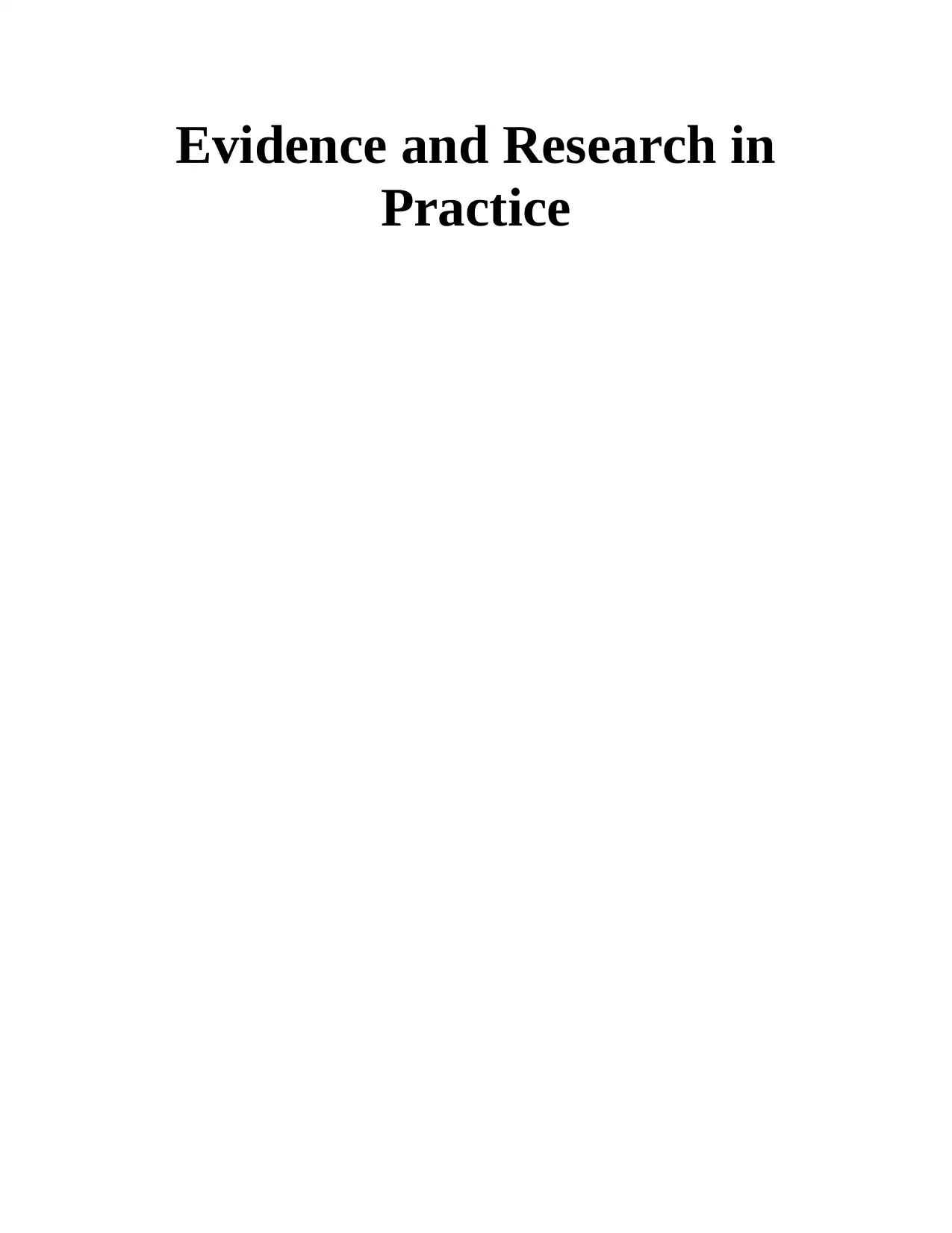
Evidence and Research in
Practice
Practice
Paraphrase This Document
Need a fresh take? Get an instant paraphrase of this document with our AI Paraphraser
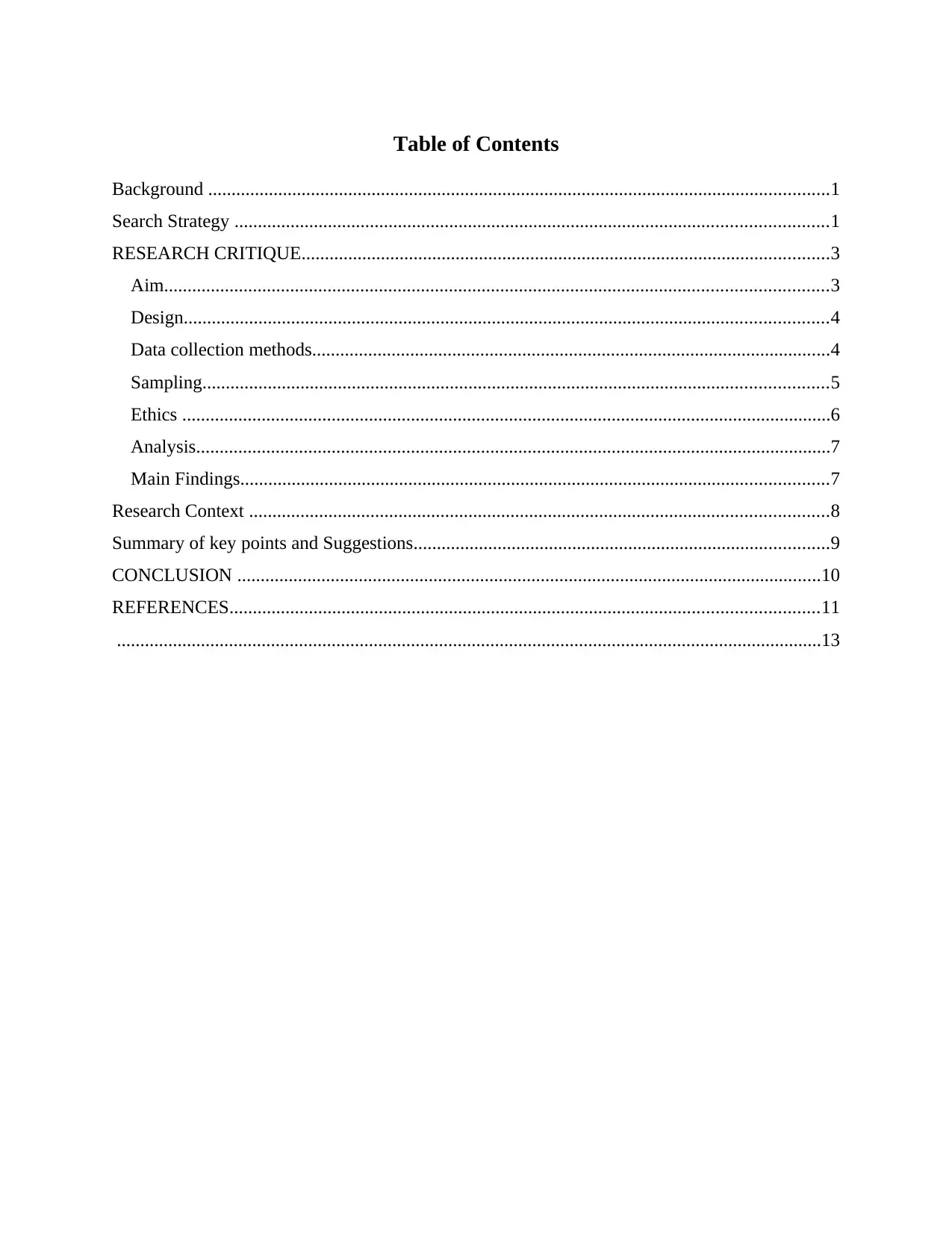
Table of Contents
Background .....................................................................................................................................1
Search Strategy ...............................................................................................................................1
RESEARCH CRITIQUE.................................................................................................................3
Aim..............................................................................................................................................3
Design..........................................................................................................................................4
Data collection methods...............................................................................................................4
Sampling......................................................................................................................................5
Ethics ...........................................................................................................................................6
Analysis........................................................................................................................................7
Main Findings..............................................................................................................................7
Research Context ............................................................................................................................8
Summary of key points and Suggestions.........................................................................................9
CONCLUSION .............................................................................................................................10
REFERENCES..............................................................................................................................11
.......................................................................................................................................................13
Background .....................................................................................................................................1
Search Strategy ...............................................................................................................................1
RESEARCH CRITIQUE.................................................................................................................3
Aim..............................................................................................................................................3
Design..........................................................................................................................................4
Data collection methods...............................................................................................................4
Sampling......................................................................................................................................5
Ethics ...........................................................................................................................................6
Analysis........................................................................................................................................7
Main Findings..............................................................................................................................7
Research Context ............................................................................................................................8
Summary of key points and Suggestions.........................................................................................9
CONCLUSION .............................................................................................................................10
REFERENCES..............................................................................................................................11
.......................................................................................................................................................13

⊘ This is a preview!⊘
Do you want full access?
Subscribe today to unlock all pages.

Trusted by 1+ million students worldwide
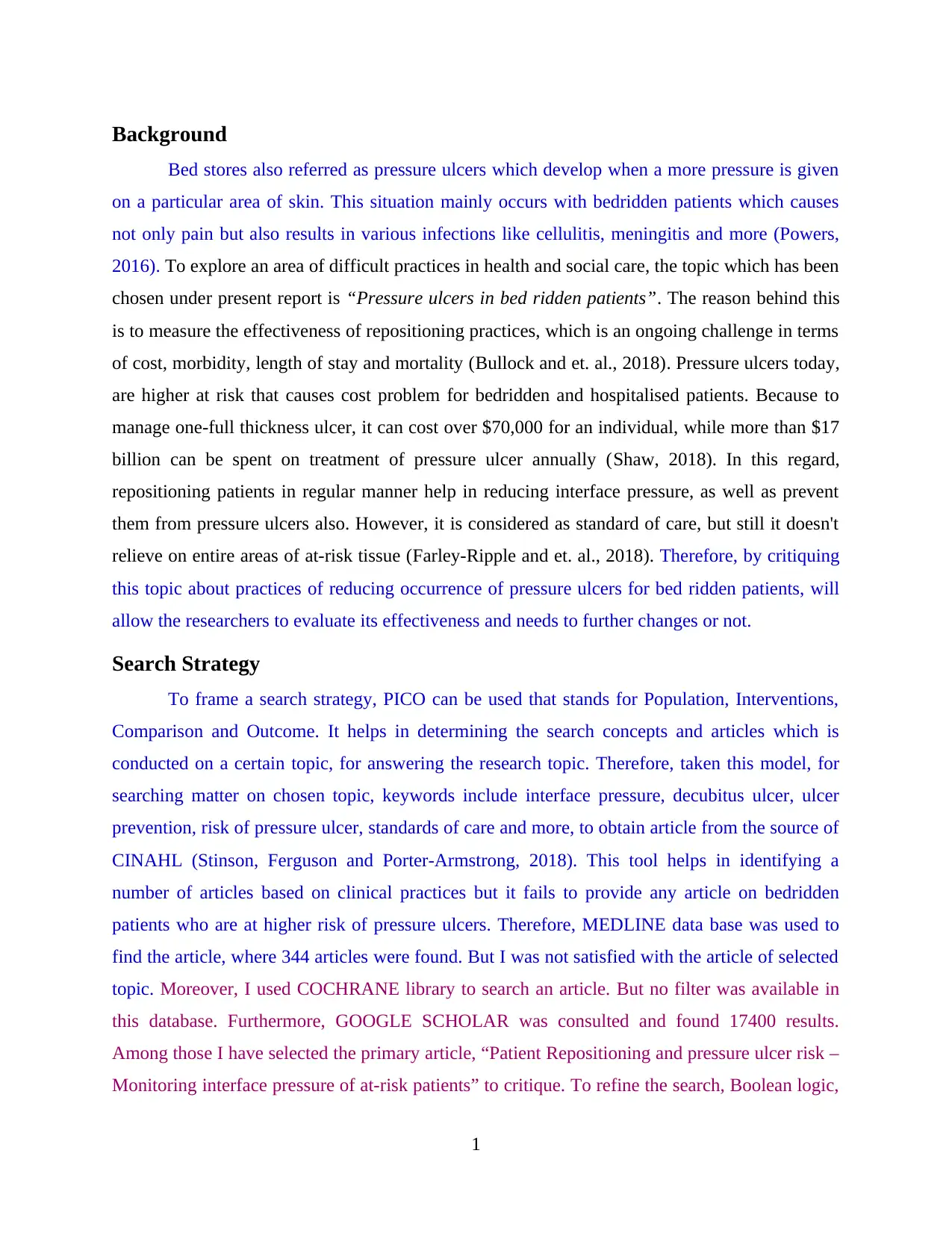
Background
Bed stores also referred as pressure ulcers which develop when a more pressure is given
on a particular area of skin. This situation mainly occurs with bedridden patients which causes
not only pain but also results in various infections like cellulitis, meningitis and more (Powers,
2016). To explore an area of difficult practices in health and social care, the topic which has been
chosen under present report is “Pressure ulcers in bed ridden patients”. The reason behind this
is to measure the effectiveness of repositioning practices, which is an ongoing challenge in terms
of cost, morbidity, length of stay and mortality (Bullock and et. al., 2018). Pressure ulcers today,
are higher at risk that causes cost problem for bedridden and hospitalised patients. Because to
manage one-full thickness ulcer, it can cost over $70,000 for an individual, while more than $17
billion can be spent on treatment of pressure ulcer annually (Shaw, 2018). In this regard,
repositioning patients in regular manner help in reducing interface pressure, as well as prevent
them from pressure ulcers also. However, it is considered as standard of care, but still it doesn't
relieve on entire areas of at-risk tissue (Farley-Ripple and et. al., 2018). Therefore, by critiquing
this topic about practices of reducing occurrence of pressure ulcers for bed ridden patients, will
allow the researchers to evaluate its effectiveness and needs to further changes or not.
Search Strategy
To frame a search strategy, PICO can be used that stands for Population, Interventions,
Comparison and Outcome. It helps in determining the search concepts and articles which is
conducted on a certain topic, for answering the research topic. Therefore, taken this model, for
searching matter on chosen topic, keywords include interface pressure, decubitus ulcer, ulcer
prevention, risk of pressure ulcer, standards of care and more, to obtain article from the source of
CINAHL (Stinson, Ferguson and Porter-Armstrong, 2018). This tool helps in identifying a
number of articles based on clinical practices but it fails to provide any article on bedridden
patients who are at higher risk of pressure ulcers. Therefore, MEDLINE data base was used to
find the article, where 344 articles were found. But I was not satisfied with the article of selected
topic. Moreover, I used COCHRANE library to search an article. But no filter was available in
this database. Furthermore, GOOGLE SCHOLAR was consulted and found 17400 results.
Among those I have selected the primary article, “Patient Repositioning and pressure ulcer risk –
Monitoring interface pressure of at-risk patients” to critique. To refine the search, Boolean logic,
1
Bed stores also referred as pressure ulcers which develop when a more pressure is given
on a particular area of skin. This situation mainly occurs with bedridden patients which causes
not only pain but also results in various infections like cellulitis, meningitis and more (Powers,
2016). To explore an area of difficult practices in health and social care, the topic which has been
chosen under present report is “Pressure ulcers in bed ridden patients”. The reason behind this
is to measure the effectiveness of repositioning practices, which is an ongoing challenge in terms
of cost, morbidity, length of stay and mortality (Bullock and et. al., 2018). Pressure ulcers today,
are higher at risk that causes cost problem for bedridden and hospitalised patients. Because to
manage one-full thickness ulcer, it can cost over $70,000 for an individual, while more than $17
billion can be spent on treatment of pressure ulcer annually (Shaw, 2018). In this regard,
repositioning patients in regular manner help in reducing interface pressure, as well as prevent
them from pressure ulcers also. However, it is considered as standard of care, but still it doesn't
relieve on entire areas of at-risk tissue (Farley-Ripple and et. al., 2018). Therefore, by critiquing
this topic about practices of reducing occurrence of pressure ulcers for bed ridden patients, will
allow the researchers to evaluate its effectiveness and needs to further changes or not.
Search Strategy
To frame a search strategy, PICO can be used that stands for Population, Interventions,
Comparison and Outcome. It helps in determining the search concepts and articles which is
conducted on a certain topic, for answering the research topic. Therefore, taken this model, for
searching matter on chosen topic, keywords include interface pressure, decubitus ulcer, ulcer
prevention, risk of pressure ulcer, standards of care and more, to obtain article from the source of
CINAHL (Stinson, Ferguson and Porter-Armstrong, 2018). This tool helps in identifying a
number of articles based on clinical practices but it fails to provide any article on bedridden
patients who are at higher risk of pressure ulcers. Therefore, MEDLINE data base was used to
find the article, where 344 articles were found. But I was not satisfied with the article of selected
topic. Moreover, I used COCHRANE library to search an article. But no filter was available in
this database. Furthermore, GOOGLE SCHOLAR was consulted and found 17400 results.
Among those I have selected the primary article, “Patient Repositioning and pressure ulcer risk –
Monitoring interface pressure of at-risk patients” to critique. To refine the search, Boolean logic,
1
Paraphrase This Document
Need a fresh take? Get an instant paraphrase of this document with our AI Paraphraser
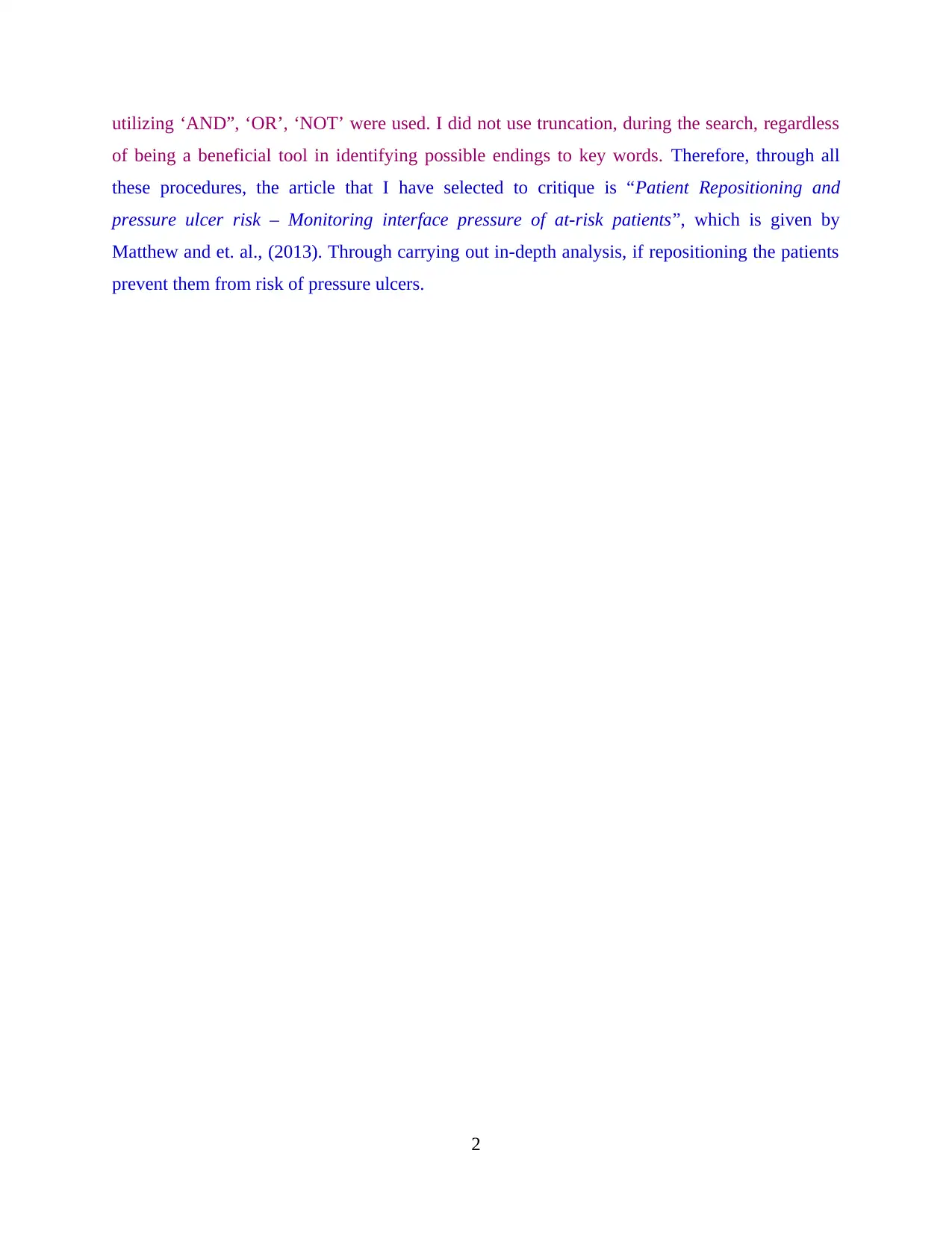
utilizing ‘AND”, ‘OR’, ‘NOT’ were used. I did not use truncation, during the search, regardless
of being a beneficial tool in identifying possible endings to key words. Therefore, through all
these procedures, the article that I have selected to critique is “Patient Repositioning and
pressure ulcer risk – Monitoring interface pressure of at-risk patients”, which is given by
Matthew and et. al., (2013). Through carrying out in-depth analysis, if repositioning the patients
prevent them from risk of pressure ulcers.
2
of being a beneficial tool in identifying possible endings to key words. Therefore, through all
these procedures, the article that I have selected to critique is “Patient Repositioning and
pressure ulcer risk – Monitoring interface pressure of at-risk patients”, which is given by
Matthew and et. al., (2013). Through carrying out in-depth analysis, if repositioning the patients
prevent them from risk of pressure ulcers.
2
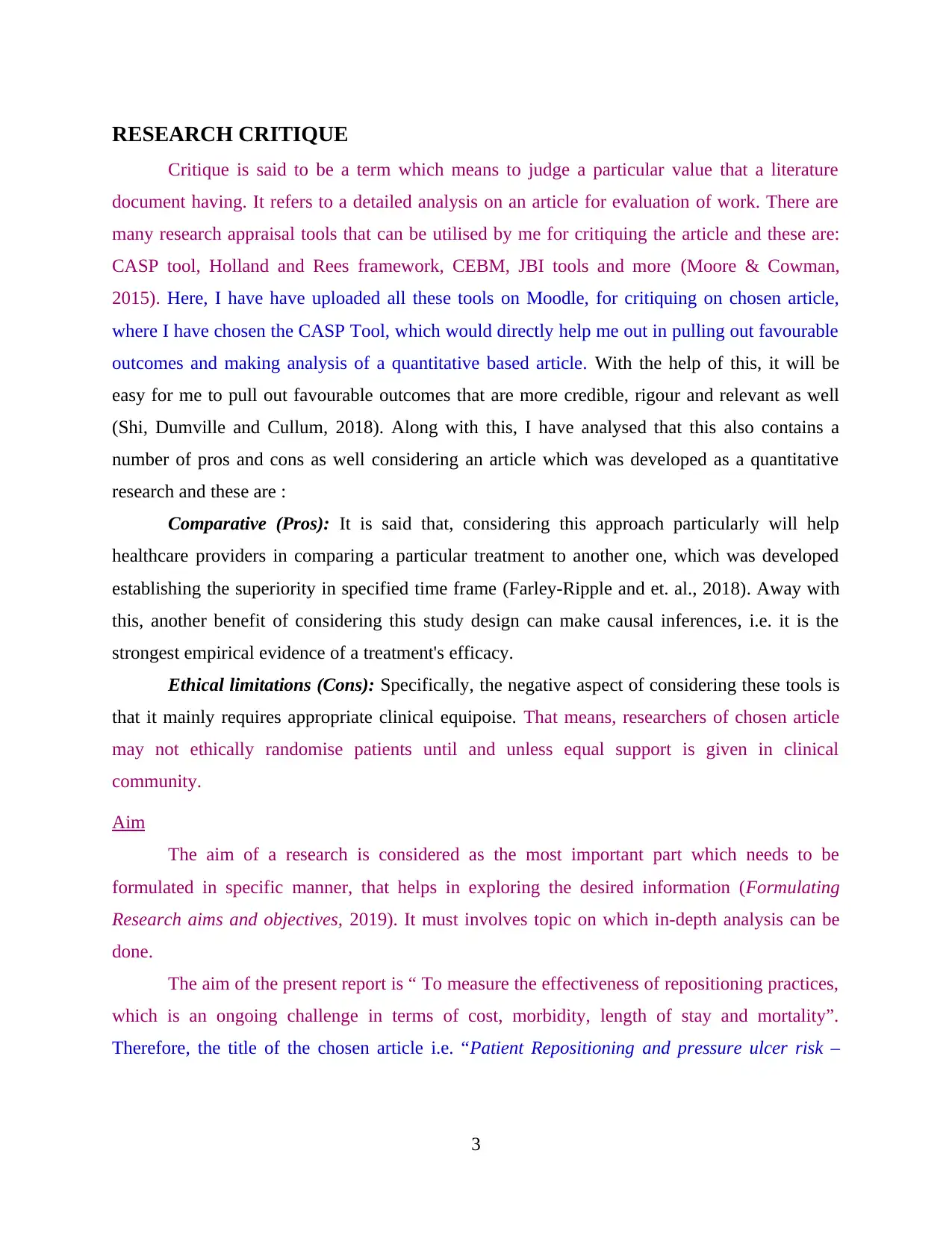
RESEARCH CRITIQUE
Critique is said to be a term which means to judge a particular value that a literature
document having. It refers to a detailed analysis on an article for evaluation of work. There are
many research appraisal tools that can be utilised by me for critiquing the article and these are:
CASP tool, Holland and Rees framework, CEBM, JBI tools and more (Moore & Cowman,
2015). Here, I have have uploaded all these tools on Moodle, for critiquing on chosen article,
where I have chosen the CASP Tool, which would directly help me out in pulling out favourable
outcomes and making analysis of a quantitative based article. With the help of this, it will be
easy for me to pull out favourable outcomes that are more credible, rigour and relevant as well
(Shi, Dumville and Cullum, 2018). Along with this, I have analysed that this also contains a
number of pros and cons as well considering an article which was developed as a quantitative
research and these are :
Comparative (Pros): It is said that, considering this approach particularly will help
healthcare providers in comparing a particular treatment to another one, which was developed
establishing the superiority in specified time frame (Farley-Ripple and et. al., 2018). Away with
this, another benefit of considering this study design can make causal inferences, i.e. it is the
strongest empirical evidence of a treatment's efficacy.
Ethical limitations (Cons): Specifically, the negative aspect of considering these tools is
that it mainly requires appropriate clinical equipoise. That means, researchers of chosen article
may not ethically randomise patients until and unless equal support is given in clinical
community.
Aim
The aim of a research is considered as the most important part which needs to be
formulated in specific manner, that helps in exploring the desired information (Formulating
Research aims and objectives, 2019). It must involves topic on which in-depth analysis can be
done.
The aim of the present report is “ To measure the effectiveness of repositioning practices,
which is an ongoing challenge in terms of cost, morbidity, length of stay and mortality”.
Therefore, the title of the chosen article i.e. “Patient Repositioning and pressure ulcer risk –
3
Critique is said to be a term which means to judge a particular value that a literature
document having. It refers to a detailed analysis on an article for evaluation of work. There are
many research appraisal tools that can be utilised by me for critiquing the article and these are:
CASP tool, Holland and Rees framework, CEBM, JBI tools and more (Moore & Cowman,
2015). Here, I have have uploaded all these tools on Moodle, for critiquing on chosen article,
where I have chosen the CASP Tool, which would directly help me out in pulling out favourable
outcomes and making analysis of a quantitative based article. With the help of this, it will be
easy for me to pull out favourable outcomes that are more credible, rigour and relevant as well
(Shi, Dumville and Cullum, 2018). Along with this, I have analysed that this also contains a
number of pros and cons as well considering an article which was developed as a quantitative
research and these are :
Comparative (Pros): It is said that, considering this approach particularly will help
healthcare providers in comparing a particular treatment to another one, which was developed
establishing the superiority in specified time frame (Farley-Ripple and et. al., 2018). Away with
this, another benefit of considering this study design can make causal inferences, i.e. it is the
strongest empirical evidence of a treatment's efficacy.
Ethical limitations (Cons): Specifically, the negative aspect of considering these tools is
that it mainly requires appropriate clinical equipoise. That means, researchers of chosen article
may not ethically randomise patients until and unless equal support is given in clinical
community.
Aim
The aim of a research is considered as the most important part which needs to be
formulated in specific manner, that helps in exploring the desired information (Formulating
Research aims and objectives, 2019). It must involves topic on which in-depth analysis can be
done.
The aim of the present report is “ To measure the effectiveness of repositioning practices,
which is an ongoing challenge in terms of cost, morbidity, length of stay and mortality”.
Therefore, the title of the chosen article i.e. “Patient Repositioning and pressure ulcer risk –
3
⊘ This is a preview!⊘
Do you want full access?
Subscribe today to unlock all pages.

Trusted by 1+ million students worldwide
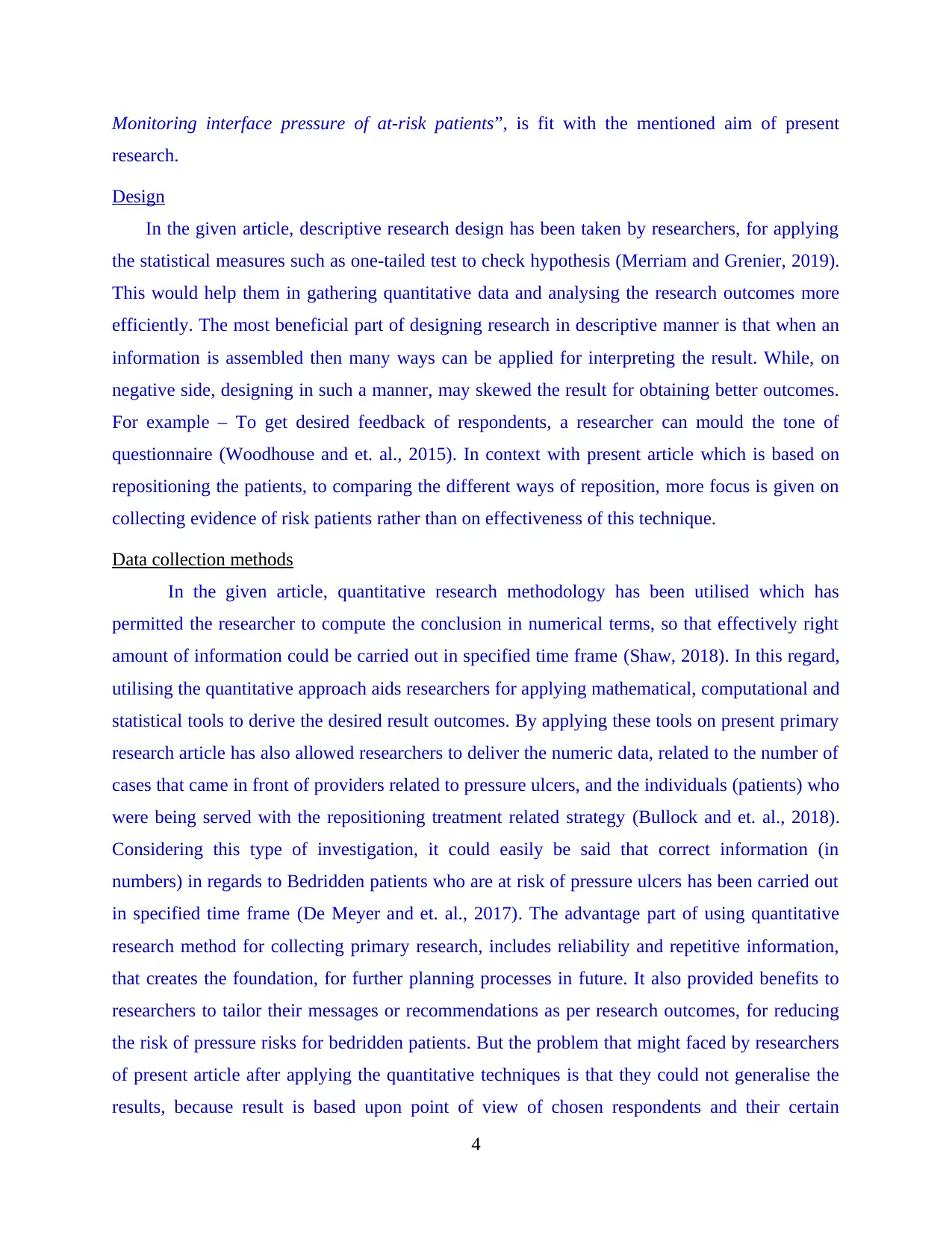
Monitoring interface pressure of at-risk patients”, is fit with the mentioned aim of present
research.
Design
In the given article, descriptive research design has been taken by researchers, for applying
the statistical measures such as one-tailed test to check hypothesis (Merriam and Grenier, 2019).
This would help them in gathering quantitative data and analysing the research outcomes more
efficiently. The most beneficial part of designing research in descriptive manner is that when an
information is assembled then many ways can be applied for interpreting the result. While, on
negative side, designing in such a manner, may skewed the result for obtaining better outcomes.
For example – To get desired feedback of respondents, a researcher can mould the tone of
questionnaire (Woodhouse and et. al., 2015). In context with present article which is based on
repositioning the patients, to comparing the different ways of reposition, more focus is given on
collecting evidence of risk patients rather than on effectiveness of this technique.
Data collection methods
In the given article, quantitative research methodology has been utilised which has
permitted the researcher to compute the conclusion in numerical terms, so that effectively right
amount of information could be carried out in specified time frame (Shaw, 2018). In this regard,
utilising the quantitative approach aids researchers for applying mathematical, computational and
statistical tools to derive the desired result outcomes. By applying these tools on present primary
research article has also allowed researchers to deliver the numeric data, related to the number of
cases that came in front of providers related to pressure ulcers, and the individuals (patients) who
were being served with the repositioning treatment related strategy (Bullock and et. al., 2018).
Considering this type of investigation, it could easily be said that correct information (in
numbers) in regards to Bedridden patients who are at risk of pressure ulcers has been carried out
in specified time frame (De Meyer and et. al., 2017). The advantage part of using quantitative
research method for collecting primary research, includes reliability and repetitive information,
that creates the foundation, for further planning processes in future. It also provided benefits to
researchers to tailor their messages or recommendations as per research outcomes, for reducing
the risk of pressure risks for bedridden patients. But the problem that might faced by researchers
of present article after applying the quantitative techniques is that they could not generalise the
results, because result is based upon point of view of chosen respondents and their certain
4
research.
Design
In the given article, descriptive research design has been taken by researchers, for applying
the statistical measures such as one-tailed test to check hypothesis (Merriam and Grenier, 2019).
This would help them in gathering quantitative data and analysing the research outcomes more
efficiently. The most beneficial part of designing research in descriptive manner is that when an
information is assembled then many ways can be applied for interpreting the result. While, on
negative side, designing in such a manner, may skewed the result for obtaining better outcomes.
For example – To get desired feedback of respondents, a researcher can mould the tone of
questionnaire (Woodhouse and et. al., 2015). In context with present article which is based on
repositioning the patients, to comparing the different ways of reposition, more focus is given on
collecting evidence of risk patients rather than on effectiveness of this technique.
Data collection methods
In the given article, quantitative research methodology has been utilised which has
permitted the researcher to compute the conclusion in numerical terms, so that effectively right
amount of information could be carried out in specified time frame (Shaw, 2018). In this regard,
utilising the quantitative approach aids researchers for applying mathematical, computational and
statistical tools to derive the desired result outcomes. By applying these tools on present primary
research article has also allowed researchers to deliver the numeric data, related to the number of
cases that came in front of providers related to pressure ulcers, and the individuals (patients) who
were being served with the repositioning treatment related strategy (Bullock and et. al., 2018).
Considering this type of investigation, it could easily be said that correct information (in
numbers) in regards to Bedridden patients who are at risk of pressure ulcers has been carried out
in specified time frame (De Meyer and et. al., 2017). The advantage part of using quantitative
research method for collecting primary research, includes reliability and repetitive information,
that creates the foundation, for further planning processes in future. It also provided benefits to
researchers to tailor their messages or recommendations as per research outcomes, for reducing
the risk of pressure risks for bedridden patients. But the problem that might faced by researchers
of present article after applying the quantitative techniques is that they could not generalise the
results, because result is based upon point of view of chosen respondents and their certain
4
Paraphrase This Document
Need a fresh take? Get an instant paraphrase of this document with our AI Paraphraser
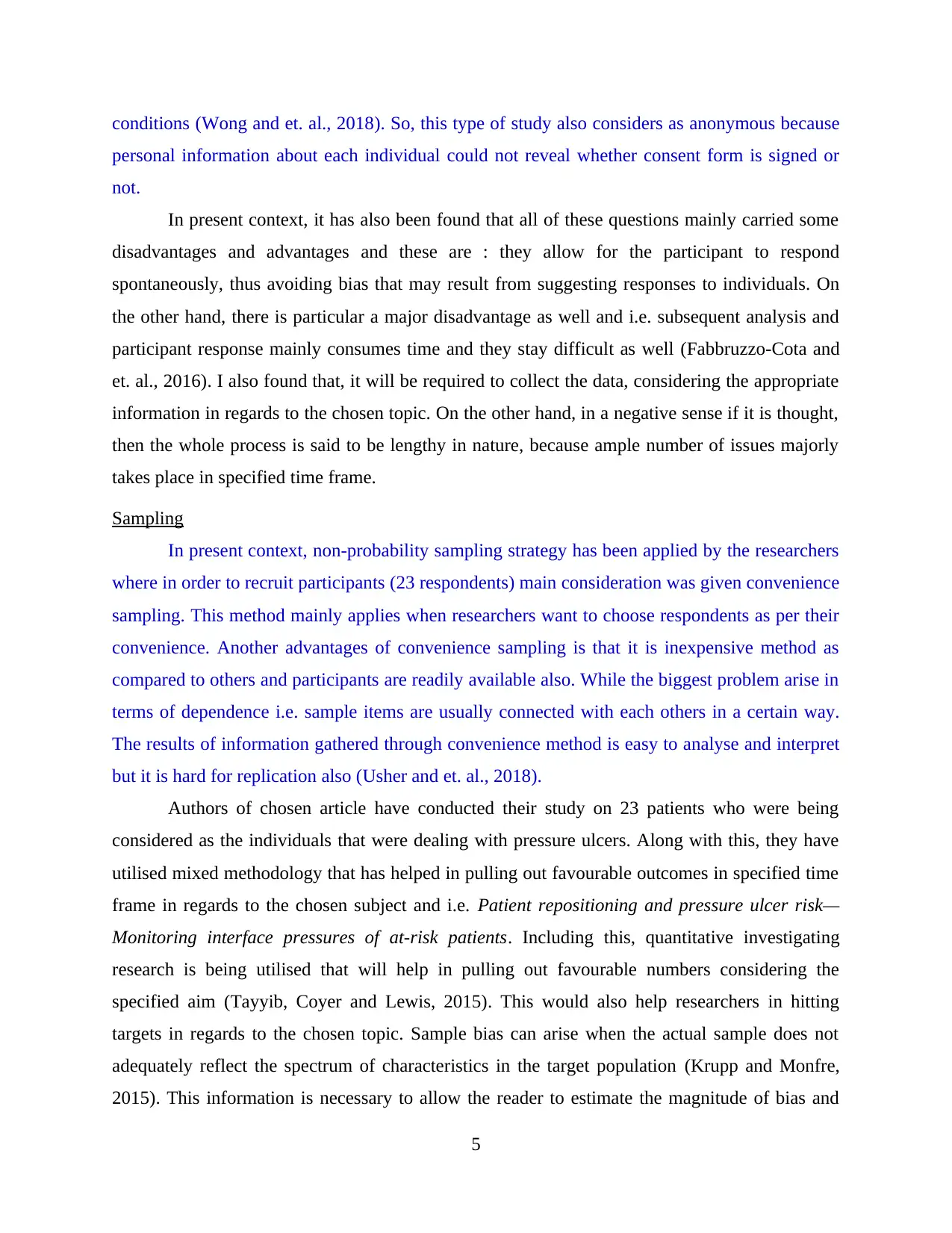
conditions (Wong and et. al., 2018). So, this type of study also considers as anonymous because
personal information about each individual could not reveal whether consent form is signed or
not.
In present context, it has also been found that all of these questions mainly carried some
disadvantages and advantages and these are : they allow for the participant to respond
spontaneously, thus avoiding bias that may result from suggesting responses to individuals. On
the other hand, there is particular a major disadvantage as well and i.e. subsequent analysis and
participant response mainly consumes time and they stay difficult as well (Fabbruzzo-Cota and
et. al., 2016). I also found that, it will be required to collect the data, considering the appropriate
information in regards to the chosen topic. On the other hand, in a negative sense if it is thought,
then the whole process is said to be lengthy in nature, because ample number of issues majorly
takes place in specified time frame.
Sampling
In present context, non-probability sampling strategy has been applied by the researchers
where in order to recruit participants (23 respondents) main consideration was given convenience
sampling. This method mainly applies when researchers want to choose respondents as per their
convenience. Another advantages of convenience sampling is that it is inexpensive method as
compared to others and participants are readily available also. While the biggest problem arise in
terms of dependence i.e. sample items are usually connected with each others in a certain way.
The results of information gathered through convenience method is easy to analyse and interpret
but it is hard for replication also (Usher and et. al., 2018).
Authors of chosen article have conducted their study on 23 patients who were being
considered as the individuals that were dealing with pressure ulcers. Along with this, they have
utilised mixed methodology that has helped in pulling out favourable outcomes in specified time
frame in regards to the chosen subject and i.e. Patient repositioning and pressure ulcer risk—
Monitoring interface pressures of at-risk patients. Including this, quantitative investigating
research is being utilised that will help in pulling out favourable numbers considering the
specified aim (Tayyib, Coyer and Lewis, 2015). This would also help researchers in hitting
targets in regards to the chosen topic. Sample bias can arise when the actual sample does not
adequately reflect the spectrum of characteristics in the target population (Krupp and Monfre,
2015). This information is necessary to allow the reader to estimate the magnitude of bias and
5
personal information about each individual could not reveal whether consent form is signed or
not.
In present context, it has also been found that all of these questions mainly carried some
disadvantages and advantages and these are : they allow for the participant to respond
spontaneously, thus avoiding bias that may result from suggesting responses to individuals. On
the other hand, there is particular a major disadvantage as well and i.e. subsequent analysis and
participant response mainly consumes time and they stay difficult as well (Fabbruzzo-Cota and
et. al., 2016). I also found that, it will be required to collect the data, considering the appropriate
information in regards to the chosen topic. On the other hand, in a negative sense if it is thought,
then the whole process is said to be lengthy in nature, because ample number of issues majorly
takes place in specified time frame.
Sampling
In present context, non-probability sampling strategy has been applied by the researchers
where in order to recruit participants (23 respondents) main consideration was given convenience
sampling. This method mainly applies when researchers want to choose respondents as per their
convenience. Another advantages of convenience sampling is that it is inexpensive method as
compared to others and participants are readily available also. While the biggest problem arise in
terms of dependence i.e. sample items are usually connected with each others in a certain way.
The results of information gathered through convenience method is easy to analyse and interpret
but it is hard for replication also (Usher and et. al., 2018).
Authors of chosen article have conducted their study on 23 patients who were being
considered as the individuals that were dealing with pressure ulcers. Along with this, they have
utilised mixed methodology that has helped in pulling out favourable outcomes in specified time
frame in regards to the chosen subject and i.e. Patient repositioning and pressure ulcer risk—
Monitoring interface pressures of at-risk patients. Including this, quantitative investigating
research is being utilised that will help in pulling out favourable numbers considering the
specified aim (Tayyib, Coyer and Lewis, 2015). This would also help researchers in hitting
targets in regards to the chosen topic. Sample bias can arise when the actual sample does not
adequately reflect the spectrum of characteristics in the target population (Krupp and Monfre,
2015). This information is necessary to allow the reader to estimate the magnitude of bias and
5
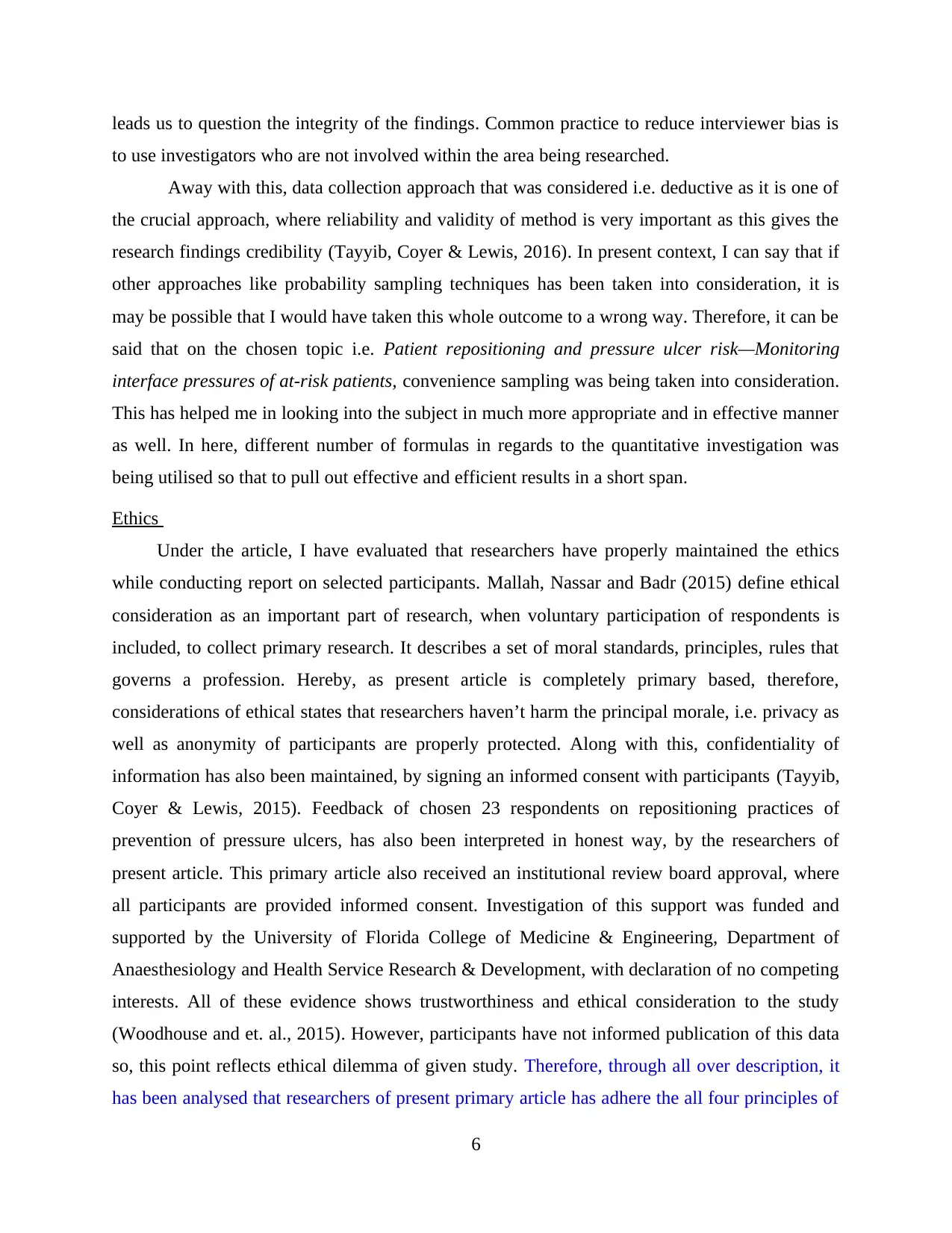
leads us to question the integrity of the findings. Common practice to reduce interviewer bias is
to use investigators who are not involved within the area being researched.
Away with this, data collection approach that was considered i.e. deductive as it is one of
the crucial approach, where reliability and validity of method is very important as this gives the
research findings credibility (Tayyib, Coyer & Lewis, 2016). In present context, I can say that if
other approaches like probability sampling techniques has been taken into consideration, it is
may be possible that I would have taken this whole outcome to a wrong way. Therefore, it can be
said that on the chosen topic i.e. Patient repositioning and pressure ulcer risk—Monitoring
interface pressures of at-risk patients, convenience sampling was being taken into consideration.
This has helped me in looking into the subject in much more appropriate and in effective manner
as well. In here, different number of formulas in regards to the quantitative investigation was
being utilised so that to pull out effective and efficient results in a short span.
Ethics
Under the article, I have evaluated that researchers have properly maintained the ethics
while conducting report on selected participants. Mallah, Nassar and Badr (2015) define ethical
consideration as an important part of research, when voluntary participation of respondents is
included, to collect primary research. It describes a set of moral standards, principles, rules that
governs a profession. Hereby, as present article is completely primary based, therefore,
considerations of ethical states that researchers haven’t harm the principal morale, i.e. privacy as
well as anonymity of participants are properly protected. Along with this, confidentiality of
information has also been maintained, by signing an informed consent with participants (Tayyib,
Coyer & Lewis, 2015). Feedback of chosen 23 respondents on repositioning practices of
prevention of pressure ulcers, has also been interpreted in honest way, by the researchers of
present article. This primary article also received an institutional review board approval, where
all participants are provided informed consent. Investigation of this support was funded and
supported by the University of Florida College of Medicine & Engineering, Department of
Anaesthesiology and Health Service Research & Development, with declaration of no competing
interests. All of these evidence shows trustworthiness and ethical consideration to the study
(Woodhouse and et. al., 2015). However, participants have not informed publication of this data
so, this point reflects ethical dilemma of given study. Therefore, through all over description, it
has been analysed that researchers of present primary article has adhere the all four principles of
6
to use investigators who are not involved within the area being researched.
Away with this, data collection approach that was considered i.e. deductive as it is one of
the crucial approach, where reliability and validity of method is very important as this gives the
research findings credibility (Tayyib, Coyer & Lewis, 2016). In present context, I can say that if
other approaches like probability sampling techniques has been taken into consideration, it is
may be possible that I would have taken this whole outcome to a wrong way. Therefore, it can be
said that on the chosen topic i.e. Patient repositioning and pressure ulcer risk—Monitoring
interface pressures of at-risk patients, convenience sampling was being taken into consideration.
This has helped me in looking into the subject in much more appropriate and in effective manner
as well. In here, different number of formulas in regards to the quantitative investigation was
being utilised so that to pull out effective and efficient results in a short span.
Ethics
Under the article, I have evaluated that researchers have properly maintained the ethics
while conducting report on selected participants. Mallah, Nassar and Badr (2015) define ethical
consideration as an important part of research, when voluntary participation of respondents is
included, to collect primary research. It describes a set of moral standards, principles, rules that
governs a profession. Hereby, as present article is completely primary based, therefore,
considerations of ethical states that researchers haven’t harm the principal morale, i.e. privacy as
well as anonymity of participants are properly protected. Along with this, confidentiality of
information has also been maintained, by signing an informed consent with participants (Tayyib,
Coyer & Lewis, 2015). Feedback of chosen 23 respondents on repositioning practices of
prevention of pressure ulcers, has also been interpreted in honest way, by the researchers of
present article. This primary article also received an institutional review board approval, where
all participants are provided informed consent. Investigation of this support was funded and
supported by the University of Florida College of Medicine & Engineering, Department of
Anaesthesiology and Health Service Research & Development, with declaration of no competing
interests. All of these evidence shows trustworthiness and ethical consideration to the study
(Woodhouse and et. al., 2015). However, participants have not informed publication of this data
so, this point reflects ethical dilemma of given study. Therefore, through all over description, it
has been analysed that researchers of present primary article has adhere the all four principles of
6
⊘ This is a preview!⊘
Do you want full access?
Subscribe today to unlock all pages.

Trusted by 1+ million students worldwide
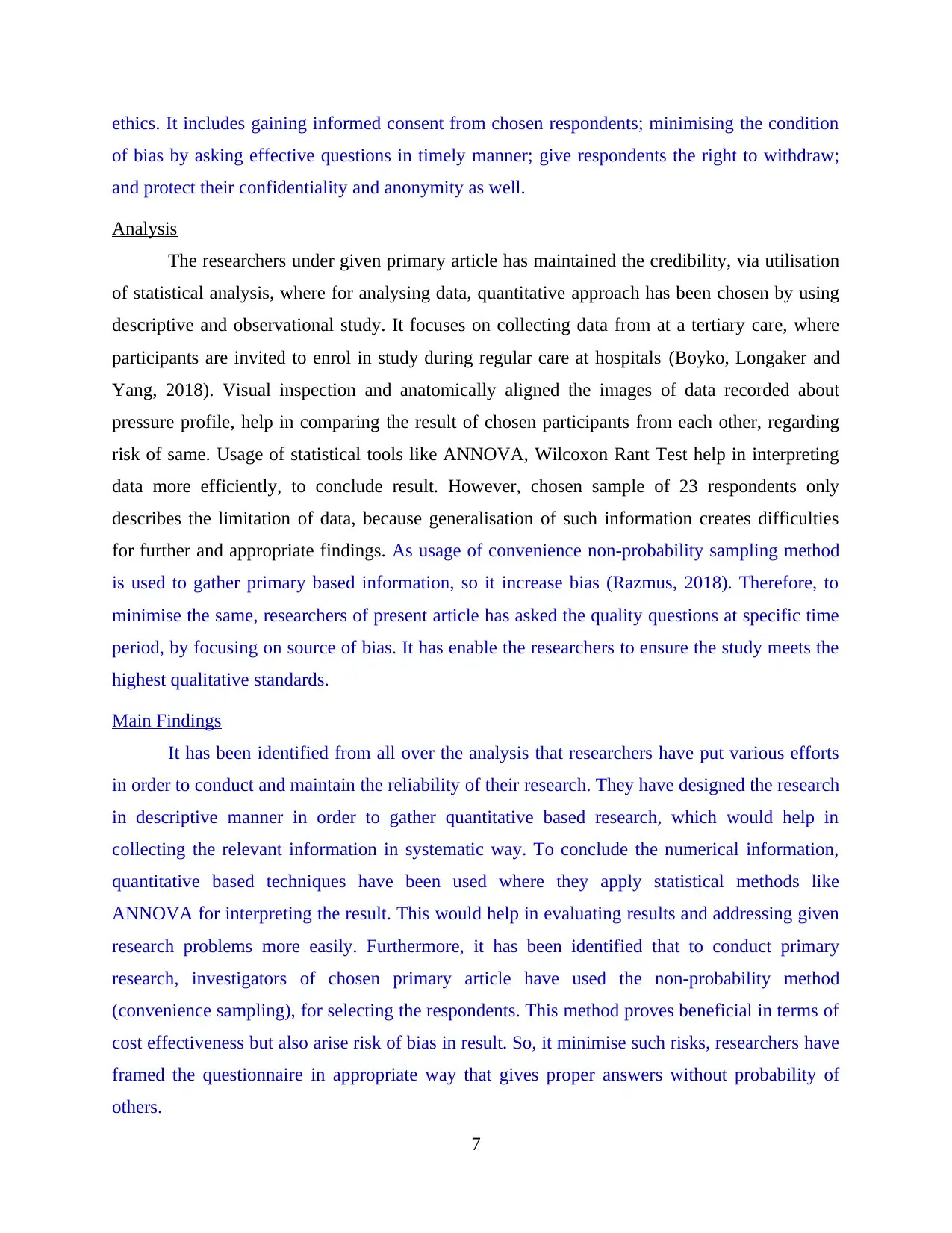
ethics. It includes gaining informed consent from chosen respondents; minimising the condition
of bias by asking effective questions in timely manner; give respondents the right to withdraw;
and protect their confidentiality and anonymity as well.
Analysis
The researchers under given primary article has maintained the credibility, via utilisation
of statistical analysis, where for analysing data, quantitative approach has been chosen by using
descriptive and observational study. It focuses on collecting data from at a tertiary care, where
participants are invited to enrol in study during regular care at hospitals (Boyko, Longaker and
Yang, 2018). Visual inspection and anatomically aligned the images of data recorded about
pressure profile, help in comparing the result of chosen participants from each other, regarding
risk of same. Usage of statistical tools like ANNOVA, Wilcoxon Rant Test help in interpreting
data more efficiently, to conclude result. However, chosen sample of 23 respondents only
describes the limitation of data, because generalisation of such information creates difficulties
for further and appropriate findings. As usage of convenience non-probability sampling method
is used to gather primary based information, so it increase bias (Razmus, 2018). Therefore, to
minimise the same, researchers of present article has asked the quality questions at specific time
period, by focusing on source of bias. It has enable the researchers to ensure the study meets the
highest qualitative standards.
Main Findings
It has been identified from all over the analysis that researchers have put various efforts
in order to conduct and maintain the reliability of their research. They have designed the research
in descriptive manner in order to gather quantitative based research, which would help in
collecting the relevant information in systematic way. To conclude the numerical information,
quantitative based techniques have been used where they apply statistical methods like
ANNOVA for interpreting the result. This would help in evaluating results and addressing given
research problems more easily. Furthermore, it has been identified that to conduct primary
research, investigators of chosen primary article have used the non-probability method
(convenience sampling), for selecting the respondents. This method proves beneficial in terms of
cost effectiveness but also arise risk of bias in result. So, it minimise such risks, researchers have
framed the questionnaire in appropriate way that gives proper answers without probability of
others.
7
of bias by asking effective questions in timely manner; give respondents the right to withdraw;
and protect their confidentiality and anonymity as well.
Analysis
The researchers under given primary article has maintained the credibility, via utilisation
of statistical analysis, where for analysing data, quantitative approach has been chosen by using
descriptive and observational study. It focuses on collecting data from at a tertiary care, where
participants are invited to enrol in study during regular care at hospitals (Boyko, Longaker and
Yang, 2018). Visual inspection and anatomically aligned the images of data recorded about
pressure profile, help in comparing the result of chosen participants from each other, regarding
risk of same. Usage of statistical tools like ANNOVA, Wilcoxon Rant Test help in interpreting
data more efficiently, to conclude result. However, chosen sample of 23 respondents only
describes the limitation of data, because generalisation of such information creates difficulties
for further and appropriate findings. As usage of convenience non-probability sampling method
is used to gather primary based information, so it increase bias (Razmus, 2018). Therefore, to
minimise the same, researchers of present article has asked the quality questions at specific time
period, by focusing on source of bias. It has enable the researchers to ensure the study meets the
highest qualitative standards.
Main Findings
It has been identified from all over the analysis that researchers have put various efforts
in order to conduct and maintain the reliability of their research. They have designed the research
in descriptive manner in order to gather quantitative based research, which would help in
collecting the relevant information in systematic way. To conclude the numerical information,
quantitative based techniques have been used where they apply statistical methods like
ANNOVA for interpreting the result. This would help in evaluating results and addressing given
research problems more easily. Furthermore, it has been identified that to conduct primary
research, investigators of chosen primary article have used the non-probability method
(convenience sampling), for selecting the respondents. This method proves beneficial in terms of
cost effectiveness but also arise risk of bias in result. So, it minimise such risks, researchers have
framed the questionnaire in appropriate way that gives proper answers without probability of
others.
7
Paraphrase This Document
Need a fresh take? Get an instant paraphrase of this document with our AI Paraphraser
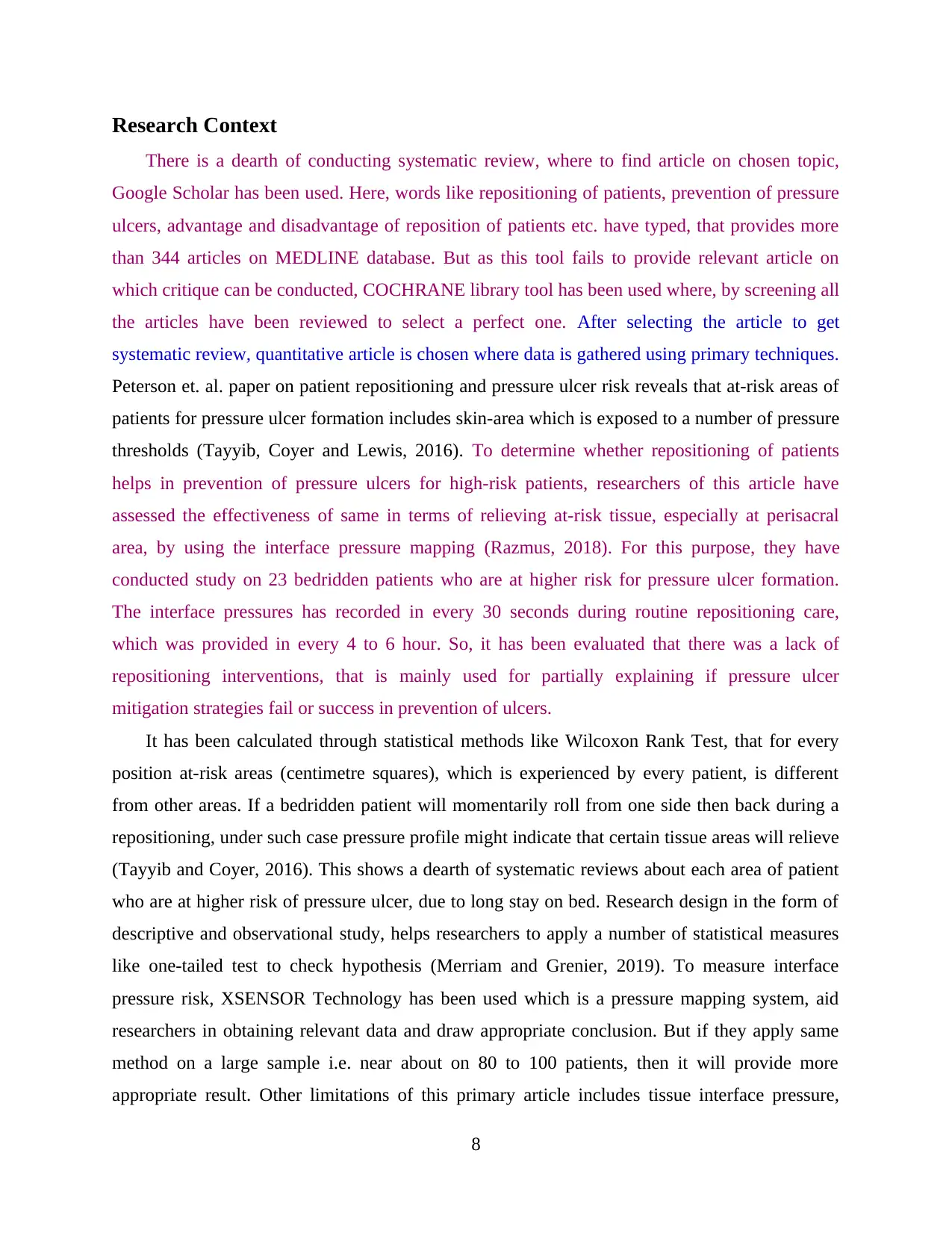
Research Context
There is a dearth of conducting systematic review, where to find article on chosen topic,
Google Scholar has been used. Here, words like repositioning of patients, prevention of pressure
ulcers, advantage and disadvantage of reposition of patients etc. have typed, that provides more
than 344 articles on MEDLINE database. But as this tool fails to provide relevant article on
which critique can be conducted, COCHRANE library tool has been used where, by screening all
the articles have been reviewed to select a perfect one. After selecting the article to get
systematic review, quantitative article is chosen where data is gathered using primary techniques.
Peterson et. al. paper on patient repositioning and pressure ulcer risk reveals that at-risk areas of
patients for pressure ulcer formation includes skin-area which is exposed to a number of pressure
thresholds (Tayyib, Coyer and Lewis, 2016). To determine whether repositioning of patients
helps in prevention of pressure ulcers for high-risk patients, researchers of this article have
assessed the effectiveness of same in terms of relieving at-risk tissue, especially at perisacral
area, by using the interface pressure mapping (Razmus, 2018). For this purpose, they have
conducted study on 23 bedridden patients who are at higher risk for pressure ulcer formation.
The interface pressures has recorded in every 30 seconds during routine repositioning care,
which was provided in every 4 to 6 hour. So, it has been evaluated that there was a lack of
repositioning interventions, that is mainly used for partially explaining if pressure ulcer
mitigation strategies fail or success in prevention of ulcers.
It has been calculated through statistical methods like Wilcoxon Rank Test, that for every
position at-risk areas (centimetre squares), which is experienced by every patient, is different
from other areas. If a bedridden patient will momentarily roll from one side then back during a
repositioning, under such case pressure profile might indicate that certain tissue areas will relieve
(Tayyib and Coyer, 2016). This shows a dearth of systematic reviews about each area of patient
who are at higher risk of pressure ulcer, due to long stay on bed. Research design in the form of
descriptive and observational study, helps researchers to apply a number of statistical measures
like one-tailed test to check hypothesis (Merriam and Grenier, 2019). To measure interface
pressure risk, XSENSOR Technology has been used which is a pressure mapping system, aid
researchers in obtaining relevant data and draw appropriate conclusion. But if they apply same
method on a large sample i.e. near about on 80 to 100 patients, then it will provide more
appropriate result. Other limitations of this primary article includes tissue interface pressure,
8
There is a dearth of conducting systematic review, where to find article on chosen topic,
Google Scholar has been used. Here, words like repositioning of patients, prevention of pressure
ulcers, advantage and disadvantage of reposition of patients etc. have typed, that provides more
than 344 articles on MEDLINE database. But as this tool fails to provide relevant article on
which critique can be conducted, COCHRANE library tool has been used where, by screening all
the articles have been reviewed to select a perfect one. After selecting the article to get
systematic review, quantitative article is chosen where data is gathered using primary techniques.
Peterson et. al. paper on patient repositioning and pressure ulcer risk reveals that at-risk areas of
patients for pressure ulcer formation includes skin-area which is exposed to a number of pressure
thresholds (Tayyib, Coyer and Lewis, 2016). To determine whether repositioning of patients
helps in prevention of pressure ulcers for high-risk patients, researchers of this article have
assessed the effectiveness of same in terms of relieving at-risk tissue, especially at perisacral
area, by using the interface pressure mapping (Razmus, 2018). For this purpose, they have
conducted study on 23 bedridden patients who are at higher risk for pressure ulcer formation.
The interface pressures has recorded in every 30 seconds during routine repositioning care,
which was provided in every 4 to 6 hour. So, it has been evaluated that there was a lack of
repositioning interventions, that is mainly used for partially explaining if pressure ulcer
mitigation strategies fail or success in prevention of ulcers.
It has been calculated through statistical methods like Wilcoxon Rank Test, that for every
position at-risk areas (centimetre squares), which is experienced by every patient, is different
from other areas. If a bedridden patient will momentarily roll from one side then back during a
repositioning, under such case pressure profile might indicate that certain tissue areas will relieve
(Tayyib and Coyer, 2016). This shows a dearth of systematic reviews about each area of patient
who are at higher risk of pressure ulcer, due to long stay on bed. Research design in the form of
descriptive and observational study, helps researchers to apply a number of statistical measures
like one-tailed test to check hypothesis (Merriam and Grenier, 2019). To measure interface
pressure risk, XSENSOR Technology has been used which is a pressure mapping system, aid
researchers in obtaining relevant data and draw appropriate conclusion. But if they apply same
method on a large sample i.e. near about on 80 to 100 patients, then it will provide more
appropriate result. Other limitations of this primary article includes tissue interface pressure,
8
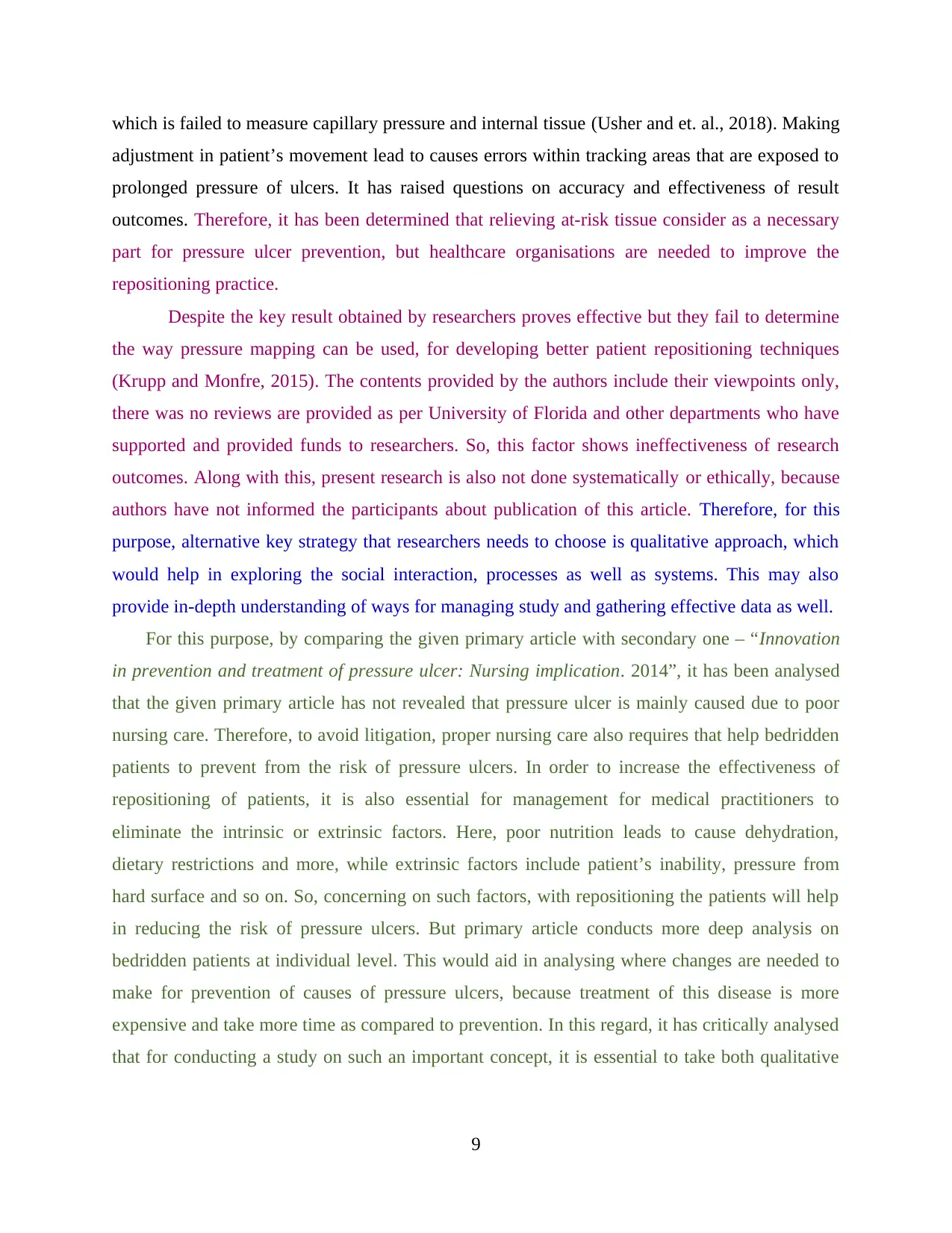
which is failed to measure capillary pressure and internal tissue (Usher and et. al., 2018). Making
adjustment in patient’s movement lead to causes errors within tracking areas that are exposed to
prolonged pressure of ulcers. It has raised questions on accuracy and effectiveness of result
outcomes. Therefore, it has been determined that relieving at-risk tissue consider as a necessary
part for pressure ulcer prevention, but healthcare organisations are needed to improve the
repositioning practice.
Despite the key result obtained by researchers proves effective but they fail to determine
the way pressure mapping can be used, for developing better patient repositioning techniques
(Krupp and Monfre, 2015). The contents provided by the authors include their viewpoints only,
there was no reviews are provided as per University of Florida and other departments who have
supported and provided funds to researchers. So, this factor shows ineffectiveness of research
outcomes. Along with this, present research is also not done systematically or ethically, because
authors have not informed the participants about publication of this article. Therefore, for this
purpose, alternative key strategy that researchers needs to choose is qualitative approach, which
would help in exploring the social interaction, processes as well as systems. This may also
provide in-depth understanding of ways for managing study and gathering effective data as well.
For this purpose, by comparing the given primary article with secondary one – “Innovation
in prevention and treatment of pressure ulcer: Nursing implication. 2014”, it has been analysed
that the given primary article has not revealed that pressure ulcer is mainly caused due to poor
nursing care. Therefore, to avoid litigation, proper nursing care also requires that help bedridden
patients to prevent from the risk of pressure ulcers. In order to increase the effectiveness of
repositioning of patients, it is also essential for management for medical practitioners to
eliminate the intrinsic or extrinsic factors. Here, poor nutrition leads to cause dehydration,
dietary restrictions and more, while extrinsic factors include patient’s inability, pressure from
hard surface and so on. So, concerning on such factors, with repositioning the patients will help
in reducing the risk of pressure ulcers. But primary article conducts more deep analysis on
bedridden patients at individual level. This would aid in analysing where changes are needed to
make for prevention of causes of pressure ulcers, because treatment of this disease is more
expensive and take more time as compared to prevention. In this regard, it has critically analysed
that for conducting a study on such an important concept, it is essential to take both qualitative
9
adjustment in patient’s movement lead to causes errors within tracking areas that are exposed to
prolonged pressure of ulcers. It has raised questions on accuracy and effectiveness of result
outcomes. Therefore, it has been determined that relieving at-risk tissue consider as a necessary
part for pressure ulcer prevention, but healthcare organisations are needed to improve the
repositioning practice.
Despite the key result obtained by researchers proves effective but they fail to determine
the way pressure mapping can be used, for developing better patient repositioning techniques
(Krupp and Monfre, 2015). The contents provided by the authors include their viewpoints only,
there was no reviews are provided as per University of Florida and other departments who have
supported and provided funds to researchers. So, this factor shows ineffectiveness of research
outcomes. Along with this, present research is also not done systematically or ethically, because
authors have not informed the participants about publication of this article. Therefore, for this
purpose, alternative key strategy that researchers needs to choose is qualitative approach, which
would help in exploring the social interaction, processes as well as systems. This may also
provide in-depth understanding of ways for managing study and gathering effective data as well.
For this purpose, by comparing the given primary article with secondary one – “Innovation
in prevention and treatment of pressure ulcer: Nursing implication. 2014”, it has been analysed
that the given primary article has not revealed that pressure ulcer is mainly caused due to poor
nursing care. Therefore, to avoid litigation, proper nursing care also requires that help bedridden
patients to prevent from the risk of pressure ulcers. In order to increase the effectiveness of
repositioning of patients, it is also essential for management for medical practitioners to
eliminate the intrinsic or extrinsic factors. Here, poor nutrition leads to cause dehydration,
dietary restrictions and more, while extrinsic factors include patient’s inability, pressure from
hard surface and so on. So, concerning on such factors, with repositioning the patients will help
in reducing the risk of pressure ulcers. But primary article conducts more deep analysis on
bedridden patients at individual level. This would aid in analysing where changes are needed to
make for prevention of causes of pressure ulcers, because treatment of this disease is more
expensive and take more time as compared to prevention. In this regard, it has critically analysed
that for conducting a study on such an important concept, it is essential to take both qualitative
9
⊘ This is a preview!⊘
Do you want full access?
Subscribe today to unlock all pages.

Trusted by 1+ million students worldwide
1 out of 17
Related Documents
Your All-in-One AI-Powered Toolkit for Academic Success.
+13062052269
info@desklib.com
Available 24*7 on WhatsApp / Email
![[object Object]](/_next/static/media/star-bottom.7253800d.svg)
Unlock your academic potential
Copyright © 2020–2025 A2Z Services. All Rights Reserved. Developed and managed by ZUCOL.





